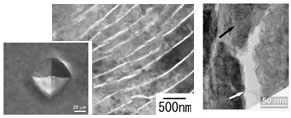Dr. Hideki Kakisawa
To break through a limitation of the performance of conventional composite materials dominated by “rule of mixture,” learning from biological composite structure with excellent mechanical properties has been a nice solution. The unique biological inorganic/organic structures provide us a clue to new composite design principles of material system, structure, interface, etc.
Nacre, for instance, is composed of 95% ceramics in volume but has quite high fracture resistance, typically thousands of times larger fracture energy than monolithic calcium carbonate without sacrificing other properties such as strength and stiffness. We are investigating the structure and toughening mechanism of nacre and are developing new materials mimicking the features of nacre.
Fig. 1 Structure of nacre. It has a “brick and mortar” structure in which inorganic rich polygonal plates (thickness ~500 nm) are stacked within an organic polymer matrix (thickness ~50 nm). Individual aragonite plates are apparently single crystals of aragonite but are actually complex aggregates of aragonite “nanograins” and organic matrix.

Fig. 2 Vickers indentation on nacre and deformation behavior beneath the indentation. Arrows indicate the organic matrix in the plate. Nacre can be yielded without cracking like metals in spite of high volume fraction of inorganic phase (95%). It is attributed by sliding at the interface between the plates and deformation of plate itself by the rearrangement of nanograins in the plates.



